Will Eos Come Down or Continue to Climb Jan 20 2018
Since Daniel Larimer announced the EOS blockchain's development, the platform has continuously caused many heated discussions and even scandals within the crypto community. What does this have to do with EOS, and why has it formed armies of haters and admirers? Will it be able to compete with Ethereum?
In our complete EOS price prediction for 2021 and 2030, we gathered all information about the project's fundamentals, ecosystem threats, historical price analysis, technical analysis and an EOS coin price prediction from experts. By the end of this article, we'll have covered everything traders and investors need to know about EOS.
EOS' Origin
EOS was presented for the first time as a concept at the Consensus conference in 2017. Even then, the personality of EOS founder, Daniel Larimer, had a very positive impact on experts' forecasts regarding the future of the new cryptocurrency project. At that time, Larimer was known in the crypto community for the BitShares platform and the Steemit social platform projects.
EOS is a product created jointly with the Block.one team. Larimer is one of the few people in the world who has managed to communicate personally, albeit anonymously, with the Bitcoin creator Satoshi Nakamoto. The EOS project aims to create software for a variety of decentralised applications. One of the project's main objectives is to make transactions much cheaper and faster.

In many ways, EOS is a revision of Ethereum's concept and core functionality (read our blog article What is Ethereum (ETH)? for more info on Ethereum). It's also a platform to place smart contracts for decentralised applications (dApps) created for ordinary customers. At the same time, developers aren't even trying to hide their intentions to bite off some of Ethereum's market share.
What is EOS?
EOS is a cryptocurrency and blockchain operating as a decentralised platform with smart contract support for creating decentralised applications. EOS token holders can sponsor the creation of apps within the platform, while platform users can run them without buying tokens.
Within the project, commissions are charged by a unique algorithm. This guarantees that the calculation, storage capacity and bandwidth are equivalent to the proportionally distributed number of EOS located in an app. EOS's main feature is the delegated proof-of-stake protocol, or DPoS, a distributed consensus aimed at achieving so-called 'technological democracy'.
Larimer risked challenging the usual PoS. In standard networks built on PoS, any wallet with coins can place a stake. It takes part in the confirmation of transactions and organisation of a decentralised consensus, thus bringing profit to the owner. DPoS wallets choose delegates who assume responsibility for verifying transactions, maintaining the blockchain, and handling transaction fees.
EOS' ICO
On 26 June 2017, EOS launched the first round of the ICO, which lasted five days and raised $185 million. During the ICO, 200 million tokens were offered, 20% of the total issuance. EOS became one of the ten highest market cap cryptocurrencies after 20% of its tokens were sold in the first phase; 10% belonged to the Block.one team. Developers distributed the remaining 70% tokens over 350 daily periods. Since EOS has no mining, buying tokens with Ethereum was the only opportunity to get new cryptocurrency.

According to the head of Block.one, Brendan Blumer, the ICO's unusual organisation was intended to avoid increased one-time interest in the project. He stated that the team believes that a one-year token distribution campaign is the best way to guarantee users an objective market value of EOS tokens. They expected that active interest would continue as the community continues to learn about the EOS blockchain and the benefits it can bring to market participants.
The cost of tokens is formed by a simple market demand mechanism and is not pegged to anything. Price determination technology is similar to the mining model. At the end of each round, tokens are distributed in proportion to the amount of Ethereum offered by users.
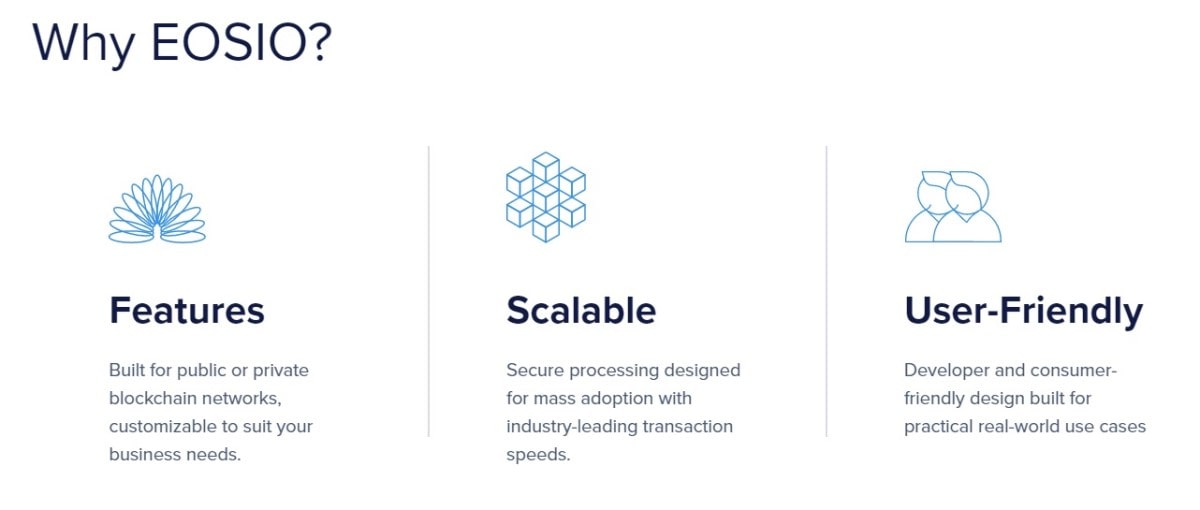
The main DPoS elements are a community, computers, cryptocurrency, established rules and the blockchain itself. In DPoS, there are selected witnesses who control the network's security. At the same time, only the top 20 most effective ones earn a profit, while hundreds of other witnesses struggle.
A delegate's weight is directly related to the number of coins in the user's wallet. The most influential community members own the most tokens. In general, the difference between PoS and DPoS is similar to the difference between direct and representative democracies.
The EOS team is on the verge of introducing an error correction capability. Since EOS uses the delegated security of shares, several node observers can make decisions without the whole network's permission.
How the EOS Blockchain Works
EOS uses a delegated proof-of-stake algorithm. This technology helps the platform cope with scalability and the load on the network during high transaction flows. In the EOS blockchain, blocks are generated every 3 seconds. Each block is created by a specific delegate randomly selected by the system at the beginning of each 21-block round.
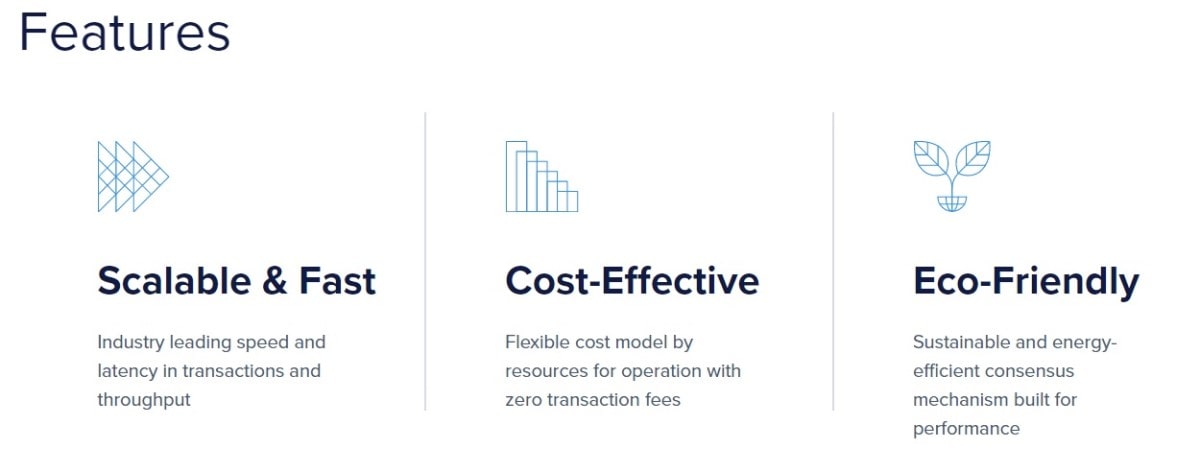
In a Proof-of-Witness (PoW) blockchain like Bitcoin, miners use a lot of computing power to solve complex mathematical equations. For general information on cryptocurrency mining for beginners, please read our blog. When the equation is solved, the miner publishes an answer confirmed by other miners in the network. A consensus is reached, the Bitcoin block is added to the blockchain, and the miner who resolved the equation receives a reward for it. Everyone then moves on to solve the next equation.
In a PoS blockchain, like Cardano, for example, some nodes reserve a certain number of tokens in a wallet for a given time and, in return, get a chance to be selected to add the next block of transactions. Although the selection is random, the reserved amount, reservation time, and node reputation are often taken into consideration.
A delegated proof-of-stake is a type of PoS in which delegates are members of the network that maintain its performance. They participate in voting, form new blocks in the blockchain, and are selected via a vote by other network token holders. Delegates maintain the network's integrity and accuracy, reaching a majority consensus on the blocks of transactions or data to be added to the network.
Another unique feature of EOS is that, instead of simply reserving EOS tokens, block producers invest in the network — its infrastructure, community support, development, and so on.
EOS Security Issues
In May 2018, there were reports of security flaws in the EOS blockchain. This news negatively affected EOS' price, and the cryptocurrency started a very tough correction after hitting its peak in April. At the end of May, a report stated that hackers revealed a large number of security problems with the EOS platform.
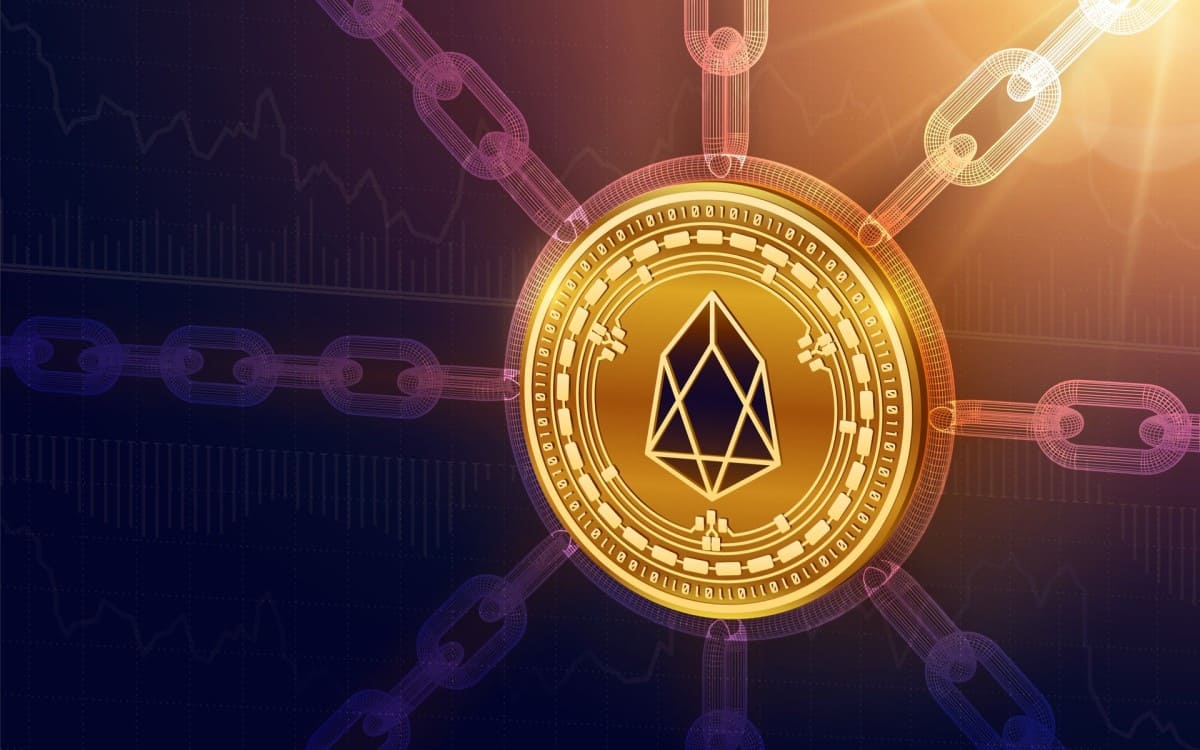
To fix code bugs and have time to prepare for the main network's launch, on 31 May 2020, developers conducted the Bug Bounty programme in which any user could find gaps in the EOS code. For each bug found, the development team promised to pay $10,000. That's how researcher Guido Vranken found $120,000 worth of bugs.
The situation was very uncomfortable for EOS developers. Releasing a bug-prone platform was not an option, so the launch had to be postponed to inspect the system's security.
Centralisation
But security problems weren't the only issue keeping EOS from taking off. Users have noted the prospect of the project becoming centralised. This is within the realm of possibility because 49.67% of tokens are placed on ten specific addresses. Most of them belong to Block.one, while other holders are Bitfinex, Binance and Bithumb.
If all major holders cooperate, the system could become centralised. That would be possible if they managed to buy back another 1.33% of all tokens. In this collusion scenario, the top holders would have 51% of all tokens in their hands, which would destroy EOS' decentralisation and present a serious chance of compromising the EOS blockchain.
Eos (EOS) Price Analysis
At the time of writing on 18 April 2022, Eos (EOS) is ranked 47th by market capitalisation at $2,301,428,065. The cost of one EOS token is estimated at $2.33. EOS's closest competitors are Ethereum (ETH), Stellar (XLM), Cardano (ADA) and other projects that focus on dApps and smart contracts. Here's an overview of EOS:
| EOS's Price (18 April 2022) | $2.33 |
| Market Cap | $2,301,428,065 |
| Supply / Total Supply | 987,199,040.31 EOS/ 1,023,615,135 EOS |
| Daily Trading Volume | $748,749,298 |
| All-Time High | $22.89 (29 April 2018) |
| All-Time Low | $0.480196 (23 October 2017) |
| Official Website | https://eos.io |
EOS Price History
It's crucial to analyse EOS price history to make an accurate EOS prediction.
Here's a logarithmic daily chart to show sharp price increases and decreases. Bitfinex is one of the first cryptocurrency exchanges to list EOS. When EOS was listed on 1 July 2017, its price was $1.20. On 3 July, it reached a high of $5.48.
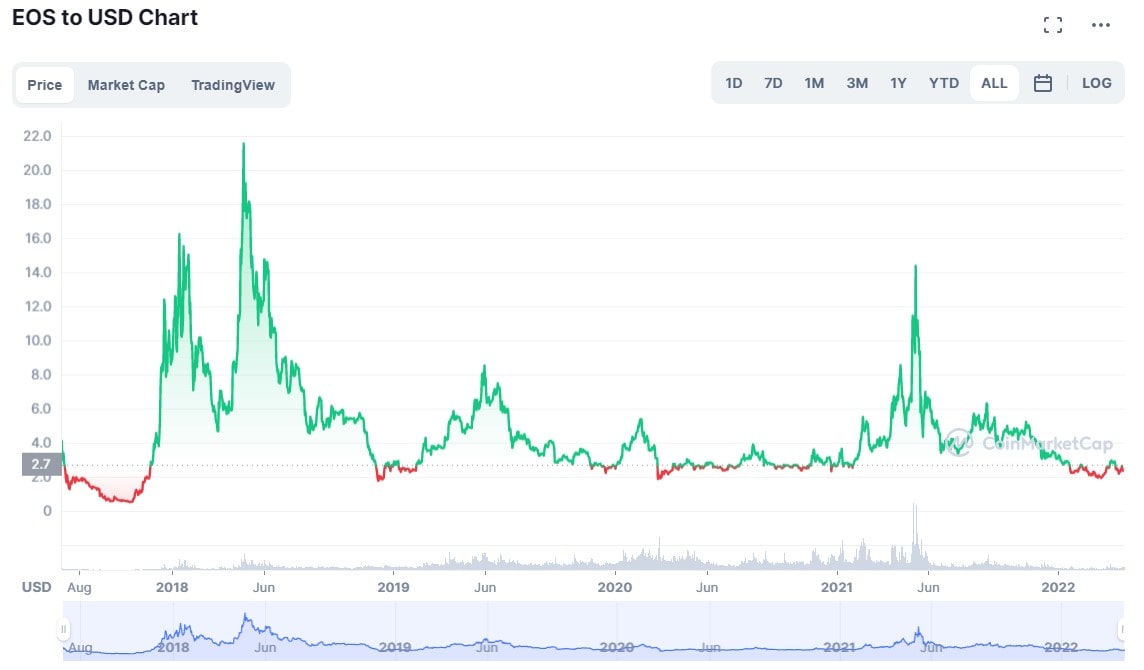
Even though EOS managed to attract the attention of the cryptocurrency industry and investors, its price dropped three days after being listed, from $5.50 to $0.50 in late October 2017. On 26 October, after gaining support from buyers, EOS started to rise, and in December 2017, its price reached a high of $12.50, rising from a low of $0.50 for a 2160% increase.
EOS Price Prediction 2018
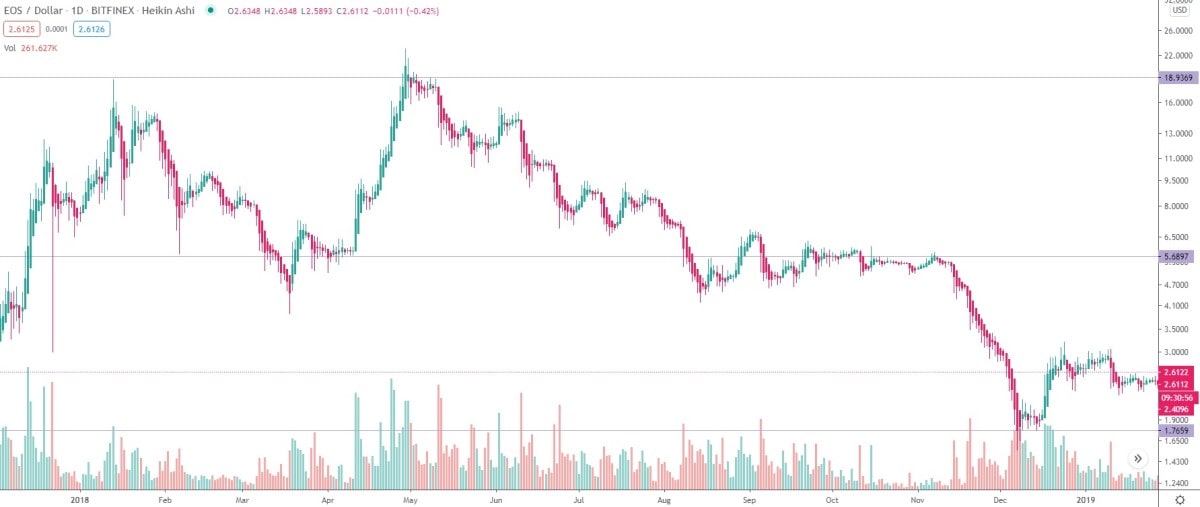
After the fantastic growth EOS showed in late December 2017, the cryptocurrency's price retreated to $7.20 on 1 January 2018. EOS opened the year on a positive note and continued upward movement, reaching $18.10 on 13 January 2018. The significant pullback across all crypto markets halted EOS' growth, and sellers dropped the price to as low as $3.90 on 18 March. A strong rebound took it to a new all-time high when EOS peaked at $22.90 on 29 April. However, the asset failed to hold that position and fell below the support level of $18, which immediately turned into resistance. The rest of the year was bearish for EOS. The price slid to as low as $1.60 on 7 December before EOS closed the year at $2.70.
EOS Price Prediction 2019
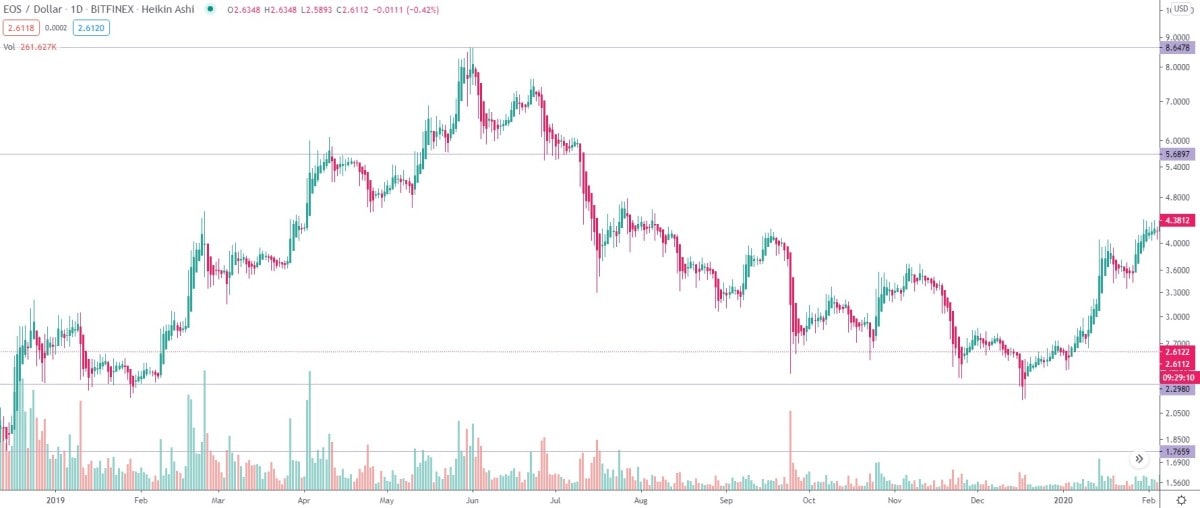
EOS performed well in the first half of 2019. After a short consolidation in the $2.20-3.00 range, buyers stepped in and pushed the asset's price to $8.50 per token on 1 June. However, after this excellent performance, the rest of the year was bearish. EOS' price declined, retesting the support level of $2.20, which had previously helped the asset to start its upward trend. On 31 December 2019, EOS traded hands for $2.65.
EOS Price Prediction 2020

It was hard to predict that the whole world would suffer from the coronavirus pandemic. EOS was among the cryptocurrencies that haven't recouped the damage done. In Q1 2020, the price of EOS performed well and reached $5.40 on 13 February. After that, it rapidly declined to as low as $1.40 by 13 March. From there, EOS grew to $3 by late April and consolidated in the $2.20-3.00 trading range by late June. On 14 August, buyers managed to break the $3-resistance level. Three days later, EOS peaked at $3.90. A pullback led the asset to the bottom of the previous trading range.
EOS Price Prediction 2021
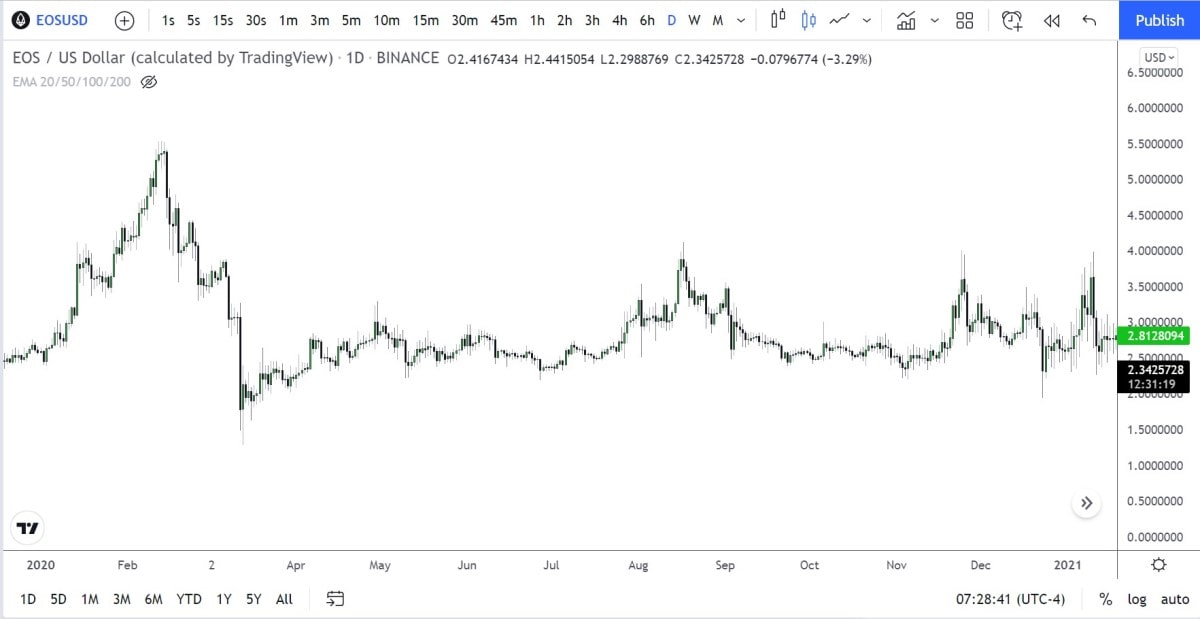
EOS began the year positively in 2021. It trended upward from the start of the year till February after the price struck a resistance around $5.50. The resistance sent EOS below the year's opening price at $1.78. The cryptocurrency tried to recover to higher prices but couldn't trade as high as the peak set in February. The price consolidated within the range of $1.78 to $5.50 until the end of the year.
Eos (EOS) Technical Analysis

The technical analysis for EOS/USD on the daily chart doesn't inspire much buying confidence. Since the sharp decline from the yearly high back in May, EOS's price has struggled to rise. It found strong support at $3.20 and rallied over 80%, but the resistance at around $6 proved to be more than a match for bulls who sought higher prices. Hope seemed to vanish once more as the significant support at around $3.20 was broken in the last days of 2021. As if that was not enough to set despair into the hearts of buyers, EOS has recently retested the flipped support at $3.20, rejecting sharply and continuing downwards.
A break below the imminent support will likely see prices get to numbers below $1.88.
Eos (EOS) Price Prediction for 2022, 2023, 2025 and 2030
The success of EOS as a blockchain and its value as a cryptocurrency will depend on the success and quality of its decentralised applications and its team's ability to remain transparent and responsive to community needs. Now let's evaluate the price prediction for EOS from popular forecasting experts and agencies.
TradingBeasts EOS Price Prediction for 2022, 2023, 2025 and 2030
Following TradingBeasts' EOS price prediction, we can assume that investors and enthusiasts won't have the best time buying this pair. TradingBeasts predicts that the price will consolidate around its current figure, and the best attempt at a rally will only reach $3.92 for the whole year. The future EOS price prediction does get better, but not a lot. They predict that the currency will only get as high as $6.00 by 2025.
WalletInvestor EOS Price Prediction for 2022, 2023, 2025 and 2030
WalletInvestor suggests that EOS may be relatively safe for long-term investment. It projects a 23.70% increase in one year. According to their price prediction, EOS will likely trade lower until the end of the year before it begins a bullish trend in early 2023. By 2024, WalletInvestor expects EOS's price to stabilise at $4.
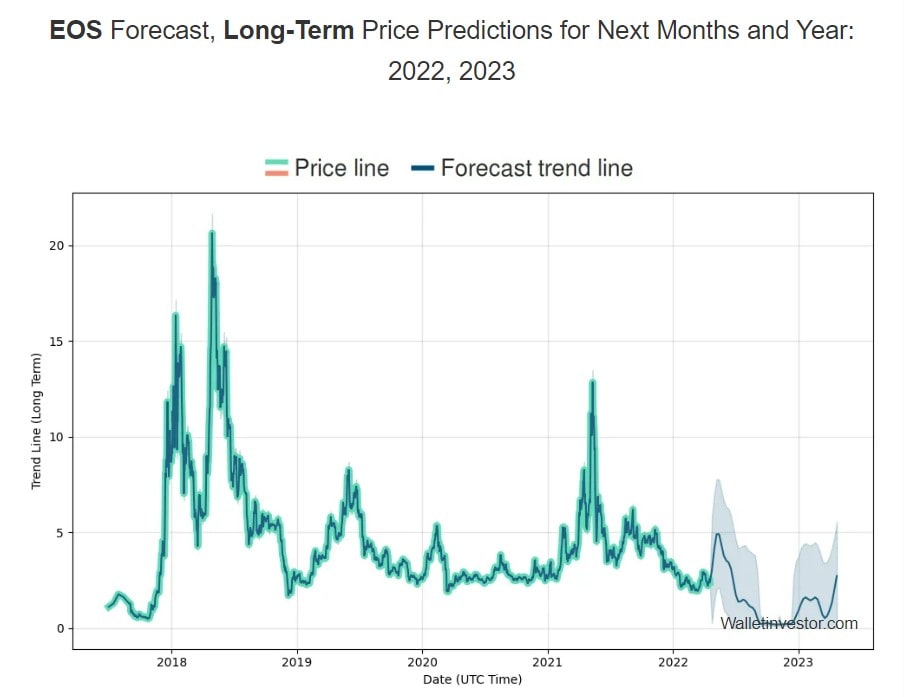
DigitalCoinPrice EOS Price Prediction for 2022, 2023, 2025, 2030
According to DigitalCoinPrice, the price of EOS may rise in the coming years. Their price prediction for EOS to reach $15 in 2021 was more than a hit, with EOS hitting a whopping $1,200. While they are more conservative now, they still expect EOS to grow in the coming years. By 2023, EOS will reach $3.72, and the price will be double that at over $6 by 2027.
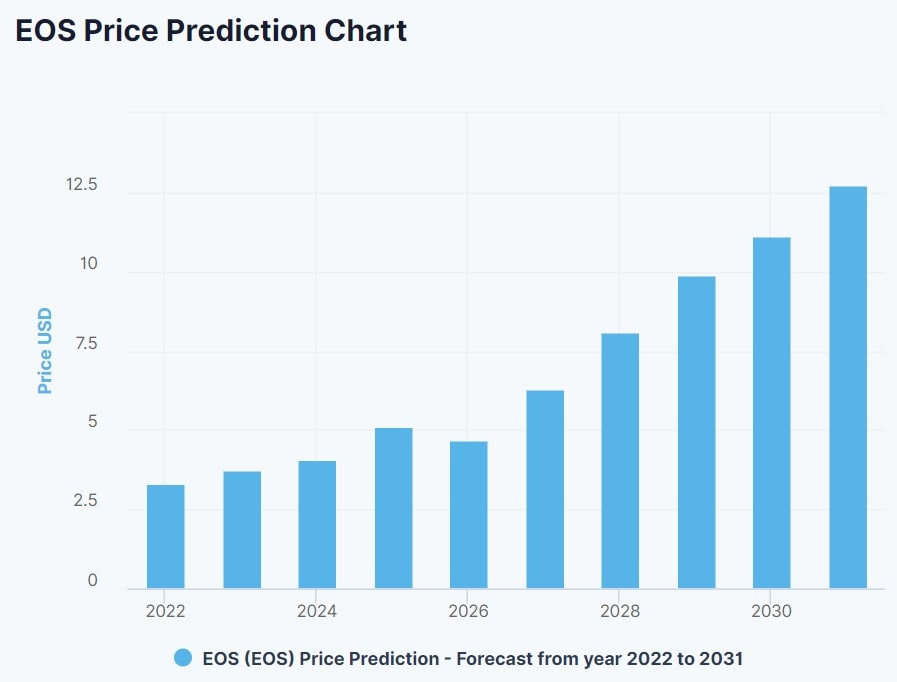
Eos (EOS) Future Value Predictions in General
EOS is an ideal tool to help developers and engineers create decentralised applications. Knowledgeable investors pay great attention to this coin because of its technology and underlying ideas. With massive investments in the coin and its experienced team, the EOS project has everything it needs to succeed in the future.
Will EOS Go Up?
Despite concerns over the project's centralisation problems, the prospects for further currency growth are quite remarkable. From its all-time high, EOS is consolidating and trading in a powerful support range. The probability of EOS growing is relatively high. It's worth remembering that general market sentiment has an impact on EOS' future price.
EOS Price Prediction Today
There's no doubt that EOS has managed to attract the attention of the cryptocurrency technology industry and investors. Record funding for the project and its experienced team are the keys to success. As long as EOS listens to its users and continues to work on its centralisation and security issues, it's only a matter of time until the project attains further success.
ackmannotenjoyard.blogspot.com
Source: https://stormgain.com/blog/eos-price-prediction